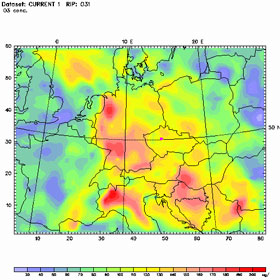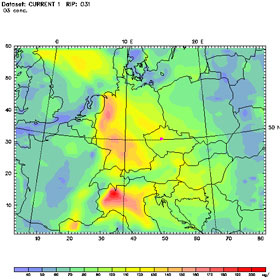
This issue in pdf Subscription Archive: Next issue: July 2005 |
|
||||||
MEDARD - An Environmental Modelling Project for the Territory of the Czech Republicby Krystof Eben, Pavel Jurus, Jaroslav Resler, Michal Belda and Bernd C. Krueger With the progress of the computing power of Linux clusters, operational installations of numerical weather prediction (NWP) models and chemistry transport models (CTM) have begun to spread through academic institutions across Europe. One such project focusing on the territory of the Czech Republic is MEDARD - a Meteorological and Environmental Data Assimilating system for Regional Domains. The system is run by the Institute of Computer Science of the Czech Academy of Sciences, in Prague. Its core consists of the NWP model MM5 (PSU/NCAR) coupled with the CTM model CAMx (ENVIRON Corp, USA). Data assimilation routines are under development. In the Czech Republic, an operational statistical predictor of summer photochemical smog situations has been used since 2000. This system uses a neural network predictor and a dynamic regression model. Its inputs are the daily maxima of tropospheric ozone concentrations and temperature, measured at the ground-level stations of the Automatic Immission Monitoring system (AIM) of the Czech Hydrometeorological institute. The resulting concentration field is obtained by means of spatial interpolation. Although this system reasonably predicts daily ozone concentration maxima, there is a need for a deterministic model which would give reliable values for regions sparsely covered by AIM stations and which would reflect the air circulation. On the other hand, deterministic models often suffer from uncertainties in emission inputs; systematic bias in some locations may occur. It is also desirable to make use of any available measurements. A system with incorporated data assimilation therefore represents a natural target for modelling efforts. The primary aim of the MEDARD project is the development of such a system for air quality forecasting. Its origins date to 2001 when the first steps were made during the EU framework V project APPETISE. The project is currently supported by the grant agency of the Academy of Sciences of the Czech Republic, within the framework of the 'Information Society' programme (No 1ET400300414). It involves researchers from the Institute of Computer Science (ICS) of the Czech Academy of Sciences, in collaboration with Charles University, the Czech Hydrometeorological Institute and the Institute of Meteorology at the University of Natural Resources and Applied Life Sciences in Vienna. A suitable NWP-CTM model pair was sought for this purpose. The most natural choice for the NWP model was MM5, which is widely used in both the USA and Europe (eg the EURAD group; http://www.eurad.uni-koeln.de). The model was configured for the territory of the Czech Republic. It has two nested domains with resolutions 27 and 9km. We run the NOAH land surface model (http://www.mmm.ucar.edu/mm5/lsm). The boundary conditions are taken from the GFS global forecast of National Centers for Environmental Prediction (NCEP, USA). The CAMx model was chosen as the CTM part of the system. CAMx has pre-processors for meteorological fields from MM5, and in our configuration it runs on two nested domains derived from the above MM5 domains. We use the Carter SAPRC99 chemistry mechanism (http://pah.cert.ucr.edu/~carter/SAPRC99.htm) and EMEP emission inventories (EMEP is a Co-operative Programme for Monitoring and Evaluation of the Long-range Transmission of Air pollutants in Europe, http://www.emep.int).
Upon the MM5-CAMx pair, a common presentation layer was built. The results are available at a user-friendly Web site intended for the general public. It was designed so as to provide a quick orientation to the situation, and features two alternative displays, animation and quick switching of domains and products. In the field of data assimilation, a type of ensemble filter suitable for the CAMx model has been proposed and is in the testing phase. Pilot experiments are being run, with the aim of determining how much data assimilation will improve operational forecasts. Figures 1 and 2 show an example of the output of an ensemble run: the ensemble mean of ozone concentration (Figure1) compared to the output of a free run without data assimilation (Figure 2). Soon after the project commenced and the first weather prediction outputs became available, demand arose from the private sector for specialized outputs like lightning activity indices, risk of icing and local wind profiles. Some products of this kind have accordingly been developed. It also emerged that public interest is biased towards weather prediction, with interest in air quality being marginal. We are attempting to attract more interest in air quality issues by presenting the outputs of the CTM as a product of comparable importance to weather forecasts. Commencing an operational run of the air quality forecast with incorporated data assimilation, however, requires a longer time schedule. Any such system will need on-line data, not only from the country immediately involved but also, due to transport phenomena, from neighbouring countries. Unfortunately there remain large differences between individual countries in the availability of on-line measurements of pollutant concentrations. A big effort has to be made in designing a system for the downloading and validation of these on-line measurements. Together with the enormous computing-power demands of assimilation methods, the development of an operational data assimilating system for air quality prediction remains a significant challenge. Link: Please contact: |
||||||



